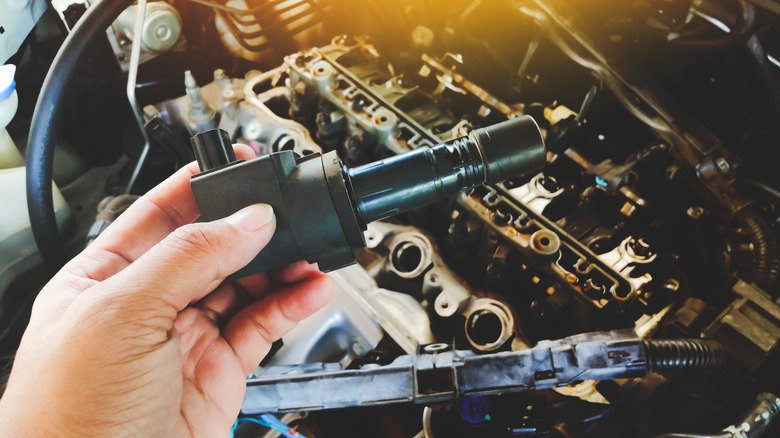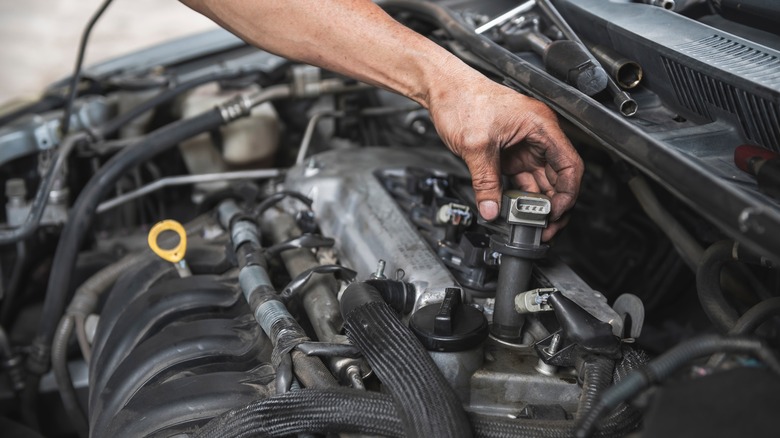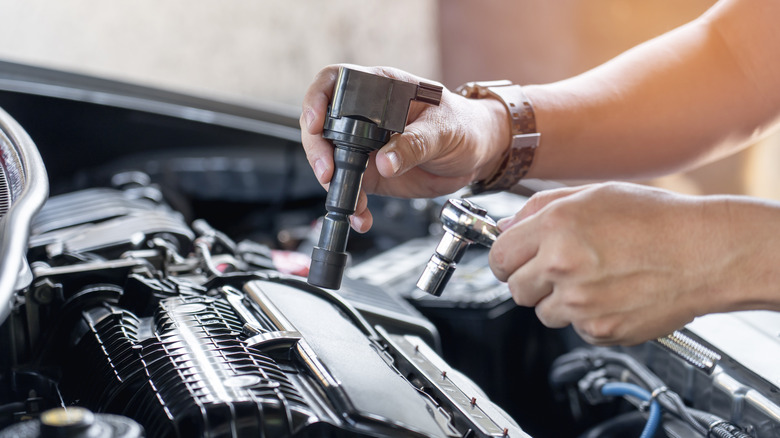Learning To Replace Ignition Coils On Your Car Is Easy, And Could Save You A Ton Of Money
The ignition coils in your car provide the high voltage electrical current that allows your spark plug to create its spark. These parts are humble looking, and they make use of relatively simple electromagnetic principles. An ignition coil has two windings, the first using between 150 and 300 turns of wire and the second boosting this value by about 100 times (15,000 to 30,000 turns). The resulting electromagnetic field takes a typical 12-volt electrical current and amplifies it to about 20,000 volts like a transformer.
The humble coil of wires is a critical component in properly functioning engines. In concert with sensors that detect the crankshaft position, the coil provides precision-timed delivery of electrical current to keep the engine moving. But over time, these sensors can fail and the ignition coils themselves can break down. This may be a result of moisture issues, or simply wear and tear through typical use.
A coil that's degraded will typically result in a check engine light, and if you allow the problem to persist, you are likely to experience rough idling, weak acceleration, and misfires in the engine. These additional stressors can spiral out into other components under the hood, making the problem much worse than a simple part replacement. Indeed, replacing the ignition coil is something you can do yourself.
How to change the coils
Changing the ignition coils in your car is a fairly simple process. It's something that even a beginner auto enthusiast can do, so it makes for a great starter project for someone looking to become more DIY-savvy when it comes to maintaining their vehicle.
The first thing you'll need to do when preparing for an ignition coil replacement revolves around your workspace. You don't want to work on a hot engine, so wait until the car is cool (or tackle the replacement before driving the vehicle during the day). To change the coil:
- First, pull up the parking brake to ensure that the car won't move during the installation, and disconnect the negative battery terminal.
- Unplug the existing ignition coil; you can find this by following the wire at the center of the distributor cap, or by locating the spark plugs.
- If you need to, remove any plastic covers or tubes that rest on top of the ignition coil.
- Once you've found, accessed, and unplugged the coil, remove the bolt holding the component in place.
- Begin wiggling on the ignition coil. The part may pull straight out or require a twist to remove, which depends on your particular car model.
- Check the new coil against the old to ensure that the new part will provide the required function, and then apply dielectric grease to the inside of the coil. If you need to change the spark plugs as well, this is when you should tackle the replacement.
- Slide the new coil into its slot and push or twist it until it clicks into place. Then, reattach the retaining bolt.
- Attach the coil's electrical connection and then replace any overlaid parts, and reattach the battery cable to the terminal.
How much it might save you
Changing the ignition coils yourself can save you a significant amount of time and money. For one thing, a single coil can cost as little as $35. However, you may need multiple ignition coils replaced, or your car may utilize a more expensive part (as much as $300 in extreme cases). If you only require a simple component, the change might take just a few minutes and cost just a few bucks.
Even for a beginner, manipulating the components and reconnecting the wiring with this new piece installed requires baseline dexterity and just a smidgeon of common sense. As well, by taking safety precautions before beginning the replacement process (unplugging the battery and engaging the parking brake), the task requires little in the way of significant safety hazards — you won't have to crawl underneath or get your hands particularly dirty.
Alternatively, bringing your vehicle into a dealership or mechanic to replace this component will cost you time, and roughly $75 to $130 extra for the charged hour that a mechanic will spend with your car (the going hourly rate in the U.S.). You may also be exposed to an upcharge for the part itself, bringing the total expense even higher. Learning to identify the telltale signs of an ignition coil that's beginning to fail can help save you cash that can and should be directed elsewhere in your budget.


